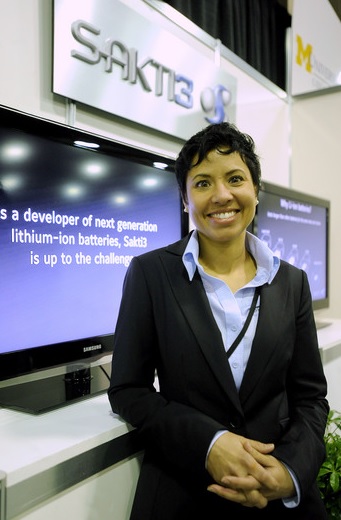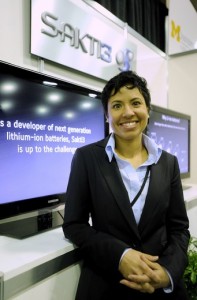
Dyson investing £11m in Sakti3 new generation battery manufacturer

Dyson is investing £11m $ 15m in US Michigan based start-up company Sakti3 batteries which specialises in next generation battery technology, to improve its products.
Sakti3 is the latest in the push by companies from electronic Group to even motor car manufacturers to find smaller, safer and more powerful batteries.
Sir James Dyson, the British Engineering entrepreneur said “Sakti3’s solid state batteries, with double the energy density of today’s lithium-ion ones is most promising technology we have come across, and if you add such battery to our digital motors, you create an extremely powerful power pack”
The Joint Venture is Dyson’s first investment in another company so that it can get exclusivity to manufacture and use Sakti3’s more powerful reliable batteries in existing products, such as its cordless and robotic vacuums.
Dyson’s sale rose to £1.3bn in 2013 boosted by exports to Asia and the household popularity of its cordless Vacuum Cleaners.
Sakti3 has raised over £22m $30m from backers so that they can focus on battery development.
Sakti’s battery technology a high performance low cost and intrinsically safe solid- state battery, was recognized with IHS CERAWeek’s Energy Innovation Pioneer Award (2014), by MIT’s Technology Review Magazine as one of the Top 50 Most Innovative Companies (2012) and World’s Top Ten, representing the “energy” category (2011).
The senior team has over 100 years’ collective experience in research, manufacturing, and leadership. The company is an offspring from the University of Michigan, which was founded in 2008, by Engineering professor Ann Marie Sastry, where its founding team created laboratories, published over 80 papers on battery technology, and demonstrated its first early prototypes.
Financed by Khosla Ventures, General Motors Ventures, Beringea and Itochu Technology Ventures, the company has been recognized for its innovative approaches in Fortune, Scientific American, Inc. The devices are manufactured using a unique combination of existing, scaled platforms.
Lithium-ion batteries are widely used in laptops, i pads, mobile phones, and in large power packs for electric and hybrid vehicles. Some batteries have caught fire including Dell, sony and even Boeing 787 aircraft.
Ann Marie Sastry is an Arthur F. Thurnau Professor of Mechanical, Biomedical and Materials Science and Engineering at the University of Michigan. She is director of the Energy Systems Engineering Program, which focuses on advanced battery technology, Academic innovator of two major research centers and a large, multidisciplinary graduate program. Technical leader in batteries, mechanics, kinetics, multiphysics, mathematics, bioscience and materials science, and director of the Engaged Academic Lives Initiative.
Sastry is the cofounder of Sakti3, a U of Michigan spinoff commercialising advanced battery designs for automotive use.
Sakti3’s prototype solid-state lithium battery cells have reached a record energy density of 1,143 Watt-hours per liter— more than double the energy density of today’s best lithium-ion batteries.
Sakti3’s technology is solid-state battery produced with the same thin-film deposition process used to make flat panel displays and photovoltaic solar cells. The cell contains no liquid electrolyte; an “interlayer” acts as both the separator, which keeps the positive and negative electrodes from coming into contact, and the electrolyte, allowing desirable ion transfers to take place. Sastry says Sakti3 will commercialise its advance safe battery technology initially with consumer electronics, followed by electric-vehicle batteries. If Sakti3 delivers what it says it has, it could be the kind of battery to give us the 300-mile, £16, 750 ($25,000) electric car.
“In my family the expectation was that I would contribute,” says Ann Marie Sastry. “My dad was a huge inspiration to me. He was my hero. And the expectation was there from a very early age that, ‘Of course, I would do mathematics.’ That is a huge advantage–that expectation that you will not only be competent at the sciences and technology, but also that your aim is to make a difference.”
“If you want to have high self-esteem, do something estimable. You can read yourself a mantra in front of the mirror every morning before you go to work, but that’s no substitute for going to work.”
“ I have been an Assistant Professor of Mechanical Engineering and Applied Mechanics at the University of Michigan for 4-1/2 years) I worked in industry and at Sandia National Laboratories. While teaching is an element of every profession, the University is the place where research and teaching are most closely tied, and I enjoy this very much. My
own research at the University of Michigan involves modeling and experimentation on statistically disordered microstructures, and then using the experiments, computer tools and analytical solutions to design better materials. It also means, in biological materials, being able to show why nature selects certain materials for certain functions, and then determine how function can be restored or improved.
My husband, Prof. Christian Lastoskie (Chemical Engineering, Michigan State University) and I went to graduate school at the same time at Cornell. My husband has always been a great source of support and inspiration to me. And, we enjoy the faculty life together tremendously”
